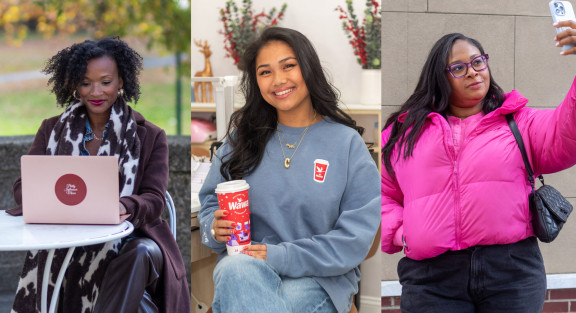Can Philly’s creator economy help rewrite the city's upward mobility story?

Creators Davida Janae (@phillyinfluencermixer), Candice Nguyen (@tropicalcandice) and Cierra Williams (@cierralikeseggs) (Madasyn Andrews for Technical.ly and Metro Philly)
By Jared Council
Candice Nguyen quit her first and only corporate job last fall to pursue content creation full time. The way things are going for her a year later, she's confident she won't be seeking a traditional 9-to-5 anytime soon.
Posting as @tropicalcandice, the 26-year-old Philadelphian consistently makes around $10,000 a month from content creation, she said, a better run rate than the $68,000 annually she previously made as a marketer. With fewer than 10,000 Instagram followers, Nguyen wouldn't exactly say she's made it big — but it has allowed her to achieve a level of lifestyle and economic freedom that exceeds what her parents had at her age.
“It's increased my economic mobility 100%,” said Nguyen, the daughter of Vietnamese refugees, who spent part of her childhood sleeping in the back of her mother's nail salon while her family lacked a permanent address. “Like, 1,000%.”
Plus, she added, “it's fun.”
Nguyen is one of an estimated 45 million Americans making a full- or part-time living off the fast-growing creator economy, which Goldman Sachs projects to be worth at least $480 billion by 2027. If more Philadelphians can tap into this industry, it might be part of a solution mix to help address one of the city’s most vexing problems: Philly children born into families with lower incomes tend to have the toughest time climbing the economic ladder.
Philadelphia is no longer the country's poorest big city, but economic mobility — defined as the likelihood a child will earn more than their parents did — is declining, according to a study released last year by research firm Opportunity Insights. Millennials born into Philly’s lower economic tiers in 1992 now earn an average of about $24,700 as adults, compared to an inflation-adjusted $27,400 for their Gen X counterparts born in 1978, the study found. That 9.7% decline in Philadelphia County was worse than the national decline of 4.2%.
No one thinks social media alone is a cure-all for the problem. But advertisers are spending more with creators than ever before, and not just with a few big stars. Brands have a growing affinity for influencers with small but engaged followings, per a 2024 study by the American Marketing Association, and for people skilled at making social-friendly videos that can be repurposed.
Because of the creator economy's low barriers to entry and the significant amount of attention it draws, some believe it holds large-scale potential for helping people improve their economic situation and lifestyle freedom.
“It's not always about making it big,” said Jess Rauchberg, an assistant professor at Seton Hall University who specializes in digital culture and social media. “I don't think that's for everyone, but I think a lot of people are interested in the comforts, the promises and the freedom that creative work brings.”
Here's some advice from Philly residents who've made content creation their primary source of income — including tips for success and some of the pitfalls to avoid.
You don't have to be on camera
For Nguyen, who quit her corporate job to become a full-time creator, most of her social media income comes from content where she doesn't show her face.
It falls into a category often referred to as user-generated content — social-media videos and posts that brands promote despite not being involved in their initial creation. One recent survey found more than 80% of marketers say this type of content outperforms assets they purposely create.
For example, Nguyen makes social-friendly food videos in which only her hands are seen. She then sells the vids to multinational brands that operate in the frozen baked goods sector. (She declined to publicly name the companies to avoid breaching her contracts.)
Her going rate: about $1,000 for a 30-second video. “I can create that in as little as 3 minutes,” she said.
Her top piece of advice is to flirt with brands. That is, make content that they would want to use — and tag them. Don't be overly annoying or aggressive in trying to get their attention; just make content in a way that's authentic to who you are.
"Make videos with products that you love, and then just tag them, and maybe they'll hire you to be contracted too," Nguyen said. "That's how I became full time. I just flirted with brands until they paid attention to me. The money comes from the brands. It doesn't come from the people."
Be patient for those first dollars
It took Cierra Williams about 8 months of consistent posting before she started making ad money on social media, she said. Today, the 29-year-old is a full-time creator.
Williams, who makes mostly lifestyle and humorous content as @cierralikeseggs, said she started posting content on TikTok in early 2023. That summer a few of her videos went viral, including a post about actress and influencer Keke Palmer (700k views) and a post about her experience with a four-day-long bout of constipation (4.2 million views). Those and other videos helped Williams gain prominence as a local influencer, and by the fall she started having brands reach out for her to create videos about them.
“It feels slow at first,” Williams said about getting paid. “And then … it just feels like, like, ‘Oh my god.’ Like, well, if this works, then what else can I do?”
With about 185k TikTok followers and 41k Instagram followers, Williams has ads on her page from companies including Listerine, Wonder Group and Stok Cold Brew. Williams said her income from corporate jobs steadily climbed from about $34,000 in 2018 to roughly $85,000 in 2023. Then in September 2024, she got laid off but her social media income had already surpassed her corporate job salary. Today, according to a review of her financial statements, she brings in at least $10,000 a month.
@cierralikeseggs gooooo birdsssssss (sorry to that man in advance) #eagles #chiefs #footballsunday #fyp ♬ original sound - Tokyo Toni
Williams advised that people not drop everything to become an influencer, because to some degree, you have to pay to play.
"If you're reviewing products constantly, or their whole thing is going out to eat, how are they paying for the meals?" Williams said. "Before the meals get comped, you still have to have money to pay for it to be seen in that space as an authoritative voice. If you want to be seen as a beauty creator, you have to buy the products. Because you're literally buying into the lifestyle."
Brace yourself for the ups and downs
Brad Linder isn't your typical content creator, but he’s carved out a living making money online similar to the way many influencers have.
Linder runs a website called Liliputing, which is a tech blog of sorts focused on small computing devices and related technologies. He writes and creates video reviews and generates revenue from display ads, affiliate links and donations.
He's been at this since 2007, when he started with an unboxing video of a ASUS Eee PC. He now has nearly two decades of experience with the ups and downs of making money online.
Over the last four or five years, he said, he’d “watch traffic dip and stay down long enough that I start to think, Oh, this is the beginning of the end. And then it usually comes back enough that I'm like, ok, maybe I got a little bit more time left.”
Linder grew up in a working class family in Ohio. He didn't go on out-of-state trips as a kid, he said, and his father at one point had a car that couldn't go into reverse. He attended Depaul University in Chicago, University of Pennsylvania and went on to work for WHYY before becoming an independent freelancer.
Then he realized he could make more money writing directly for audiences, versus writing freelance stories.
His best years were in the early 2010s, he said, including a period where Liliputing generated about $13,000 per month. But changes in Google's algorithms and user habits have made it difficult to achieve those numbers now. Today, his monthly revenue is in the high four figures. That’s lower, but it’s allowed him to take on a part-time job working at PhillyCAM, the city’s public access media nonprofit.
“Set aside some money during the good times, because those good times might not last,” Linder said. “And if I hadn't done that, then I'd be more stressed out about the drop in revenue, right? But because the house is paid off, because I do have money in the retirement account, I don't feel like I need to earn as much today as I did 10 years ago.”
Get involved with the influencer scene
As the pool of Philly-based influencers has grown, so has the local base of resources designed to recognize and support them.
Philadelphia Magazine is in the third year of its Influencer Awards gala, which honors local creators across the spectrum of content, including food, fitness, travel and sports.
Groups like Philly Creator Club and Philly Influencer Mixer have emerged in recent years as some of the prominent creator networking groups. Founded in 2019 by Davida Janae Lovelace (who also posts as @vidafashionista), Philly Influencer Mixer held its first conference in September.
"The creator community is so vast here in Philly," Lovelace said. "There's a lot of people out there doing this, but we just need some hub to connect."
The conference even featured a video address from Pennsylvania Gov. Josh Shapiro, who has hosted Philly creators in Harrisburg and appeared in some content with them.

It’s not only important to build relationships with other creators, but also with brands, Lovelace said. "You don't want to just be like a one hit wonder with brands. You want to have that relationship, maintain that relationship, build that relationship, and you want to be a go-to person for a brand."
Williams, the TikTok lifestyle creator, said meeting other creators was invaluable, especially those who could impart lessons about the business of content creation.
That’s especially important because economic connectedness — the extent to which low- and high-income people form friendships — is a key driver of upward mobility, according to the Opportunity Insights research. For Philadelphia residents with low incomes, 36% of their friends on average come from higher-income households. The national average is 40%.
Philly’s creator economy could help grow such connectedness. One thing that stands out about the Philadelphia scene to Rauchberg, the Seton Hall professor, is the level of collaboration and camaraderie. In other big cities like New York, she said, content tends to be more about the individual creator and less about the community.
“Philadelphia creators are interested in collaborating and highlighting what makes the city special," Rauchberg said. "So I see a lot of community that we don't necessarily find in other creator economies across the country."